INSTITUT SUPERIEUR D'ANTHROPOLOGIE
INSTITUTE OF ANTHROPOLOGY
ONLINE COURSES / COURS A DISTANCE
FALL TERM : OCTOBER 2015
REGISTER NOW
TURQUIE – 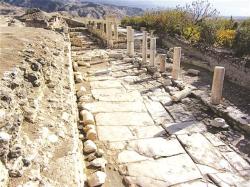 Tripolis - Two skeletons have been discovered in a sarcophagus found in a sand pit near the ancient city of Tripolis in the western province of Denizli’s Buldan district. The skeletons were estimated to belong to a couple who lived 18 centuries ago.
Tripolis - Two skeletons have been discovered in a sarcophagus found in a sand pit near the ancient city of Tripolis in the western province of Denizli’s Buldan district. The skeletons were estimated to belong to a couple who lived 18 centuries ago.
The head of excavations in the ancient city, Associated Professor Bahadır Duman, said the cover of the sarcophagus was seen during work in the sand pit and the officials of the pit informed them about it. He said in collaboration with the Denizli Museum, they had unearthed an ancient tomb, adding the tomb might date back to the 2nd or 3rd century, considering the descriptions on it, including the figures of Greek gods Hermes, Narcissus, Heracles and Thanatos. “Two people are lying inside the tomb. Most probably, a husband and a wife,” Duman said. He said the skeletons were 1.65 centimeters long and weighed about 60 kilograms. “They may have died of an epidemic,” he added.
http://www.hurriyetdailynews.com/Default.aspx?pageID=238&nid=83835&NewsCatID=375
ROYAUME UNI – 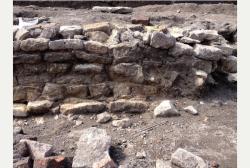 Lincoln - The discovery of a medieval wall four feet under modern
Lincoln - The discovery of a medieval wall four feet under modern Lincoln could shed new light on how the city's poorer residents scratched a living in the 12th century. Archaeologists first discovered a wall, believed to be from the Middle Ages or earlier, underneath where Gadsby's once stood. The amazing find was revealed on a site at the corner of High Street and Tentercroft Street during work on the East-West Link Road. Then, digging about a foot immediately behind this wall, a smaller wall was found that appears to run parallel to it.
Lincoln could shed new light on how the city's poorer residents scratched a living in the 12th century. Archaeologists first discovered a wall, believed to be from the Middle Ages or earlier, underneath where Gadsby's once stood. The amazing find was revealed on a site at the corner of High Street and Tentercroft Street during work on the East-West Link Road. Then, digging about a foot immediately behind this wall, a smaller wall was found that appears to run parallel to it.
http://www.lincolnshireecho.co.uk/Medieval-wall-Lincoln-s-new-link-road-immigrant-s/story-26671697-detail/story.html
USA – 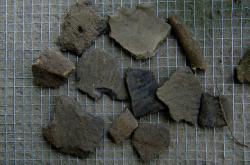 New Harmony - In a town that was established in 1814, a person can literally “trip over artifacts,” said University of Southern Indiana senior Chynna Hall. Hall has spent the beginning of her summer vacation in New Harmony with six fellow students in USI’s Archaeological Field School studying the town’s Native American inhabitants who occupied the area before the Harmonists came in 1814. Since the beginning of May through Thursday, the students, with guidance from USI Associate Professor of Anthropology Michael Strezewski, have worked test units around the perimeter of the Harmonist Cemetery at the corner of North and West streets to look for village areas located next to the eight cemetery mounds. The group also surveyed inside the cemetery. No digging took place, but the program’s new resistivity meter was used to create a map based on soil mapping data showing a never-before-identified man-made berm, or raised area of earth, surrounding the Native American burial mounds within the Harmonist Cemetery. This year students have unearthed artifacts including pottery and chert blades from the Crab Orchard phase, about 2,000 years ago.
New Harmony - In a town that was established in 1814, a person can literally “trip over artifacts,” said University of Southern Indiana senior Chynna Hall. Hall has spent the beginning of her summer vacation in New Harmony with six fellow students in USI’s Archaeological Field School studying the town’s Native American inhabitants who occupied the area before the Harmonists came in 1814. Since the beginning of May through Thursday, the students, with guidance from USI Associate Professor of Anthropology Michael Strezewski, have worked test units around the perimeter of the Harmonist Cemetery at the corner of North and West streets to look for village areas located next to the eight cemetery mounds. The group also surveyed inside the cemetery. No digging took place, but the program’s new resistivity meter was used to create a map based on soil mapping data showing a never-before-identified man-made berm, or raised area of earth, surrounding the Native American burial mounds within the Harmonist Cemetery. This year students have unearthed artifacts including pottery and chert blades from the Crab Orchard phase, about 2,000 years ago.
http://www.courierpress.com/news/local-news/education/usi-students-explore-new-harmonys-native-american-inhabitants-through-archaeological-dig_65332931
IRLANDE -  Spanish Point - Archaeologists are to undertake a study of two burial sites in Spanish Point understood to contain the remains of some of those who sailed on Spanish Armada ships wrecked off the West Clare coast. The research forms part of ongoing efforts to locate the wrecked remains of the 790-ton, 25 metre long San Marcos, which sank with the loss of 400 lives near Seafield in September 1588. In July, a team of archaeologists from Rubicon Heritage Services will conduct a geophysical survey of a site at Spanish Point that is thought to contain burials related to the San Marcos and another Spanish Armada vessel, the San Esteban. According to Irish Archaeology, it is hoped that this non-invasive survey will determine whether a mass burial did actually occur at Spanish Point. Representing the pride of the Spanish Navy, the San Esteban and San Marcos ships sank during a violent storm on the 20th of September 1588, with the loss of over 700 men (both sailors and soldiers). They had been attempting to return to Spain, via the west coast of Ireland, after a disastrous encounter with the English Navy. Roughly 60 survivors from the two ill-fated ships made it ashore, where they were promptly captured by Boetius Clancy, High Sheriff of Clare. The Spanish sailors were shown little mercy and after a short imprisonment were hanged on a nearby hill. Their remains were subsequently buried in a mass grave on Spanish Point, the suspected site of which is now being investigated by Rubicon Heritage Services.
Spanish Point - Archaeologists are to undertake a study of two burial sites in Spanish Point understood to contain the remains of some of those who sailed on Spanish Armada ships wrecked off the West Clare coast. The research forms part of ongoing efforts to locate the wrecked remains of the 790-ton, 25 metre long San Marcos, which sank with the loss of 400 lives near Seafield in September 1588. In July, a team of archaeologists from Rubicon Heritage Services will conduct a geophysical survey of a site at Spanish Point that is thought to contain burials related to the San Marcos and another Spanish Armada vessel, the San Esteban. According to Irish Archaeology, it is hoped that this non-invasive survey will determine whether a mass burial did actually occur at Spanish Point. Representing the pride of the Spanish Navy, the San Esteban and San Marcos ships sank during a violent storm on the 20th of September 1588, with the loss of over 700 men (both sailors and soldiers). They had been attempting to return to Spain, via the west coast of Ireland, after a disastrous encounter with the English Navy. Roughly 60 survivors from the two ill-fated ships made it ashore, where they were promptly captured by Boetius Clancy, High Sheriff of Clare. The Spanish sailors were shown little mercy and after a short imprisonment were hanged on a nearby hill. Their remains were subsequently buried in a mass grave on Spanish Point, the suspected site of which is now being investigated by Rubicon Heritage Services.
http://clareherald.com/2015/06/archaeologists-to-probe-spanish-armada-burial-site-in-clare-5675/
TURQUIE – 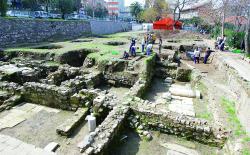 Izmir - Archaeological excavations in İzmir that have made great contributions to the city’s culture and tourism, currently face the obstacle of obtaining a sponsorship contract. The Agora, Kadifekale’s ancient theater, Yeşilova, Foça, Altınpark and Bayraklı excavations that were set to start six months ago are still waiting for approval from the Culture and Tourism Ministry. Archaeologists have gone unpaid for six months. Some are now unemployed. The main sponsor of the excavations is the İzmir Metropolitan Municipality, with the İzmir Trade Chamber and local municipalities providing additional support. The sponsorship agreement is renewed by the Culture and Tourism Ministry every year. But the budget provided by the ministry is enough for three months at most. It is impossible to maintain excavations without sponsors.
Izmir - Archaeological excavations in İzmir that have made great contributions to the city’s culture and tourism, currently face the obstacle of obtaining a sponsorship contract. The Agora, Kadifekale’s ancient theater, Yeşilova, Foça, Altınpark and Bayraklı excavations that were set to start six months ago are still waiting for approval from the Culture and Tourism Ministry. Archaeologists have gone unpaid for six months. Some are now unemployed. The main sponsor of the excavations is the İzmir Metropolitan Municipality, with the İzmir Trade Chamber and local municipalities providing additional support. The sponsorship agreement is renewed by the Culture and Tourism Ministry every year. But the budget provided by the ministry is enough for three months at most. It is impossible to maintain excavations without sponsors.
http://www.hurriyetdailynews.com/izmir-excavations-wait-for-approval-.aspx?pageID=238&nID=83784&NewsCatID=375
USA – Eckley Miners’ Village - Archaeology students are finding trinkets and treasures hidden underground at Eckley Miners’ Village. They hope to tell a more complete story of the people who used to live there. Digging up artifacts and telling the area’s coal mining history. That’s what a team of archaeologists is doing to the soil near Freeland in a part of Eckley Miners’ Village that hasn’t been touched in 150 years. “We don’t know a lot about them. There isn’t a lot in the historical record, but by doing archaeology work, we can take a look at their material culture, and make some inferences about how they lived their lives,” said Eckley administrator Bode Morin. When the team finds artifacts it gives them a glimpse of the lives of the people who used to live there. “We’ve also been finding everyday stuff like ceramics, nails that would have been used to build houses.” Camille Westmont studies at the University of Maryland and is working on her dissertation. She says items such as a marble or the arm of a small doll tell a lot about the families who lived here. “It’s not that they were sending all their children to work, it’s that they wanted their kids to have a good childhood,” Westmont said.
VIDEO = http://wnep.com/2015/06/10/digging-up-history/
MALTE – 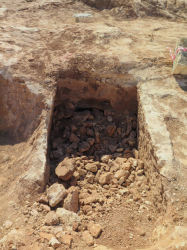 Kirkop - An important archaeological find was made in Kirkop during the construction of a new secondary school in the area. According to a government statement, the archaeological remains include at least seven ancient tombs in the rocks. Furthermore it seems that some of the tombs date back to the early Roman period and there seem to be suggestions that some Christian catacombs have also been found. The statement explains that the tombs were found in Triq il- Paleo Kristjani, close to already well-known tombs.
Kirkop - An important archaeological find was made in Kirkop during the construction of a new secondary school in the area. According to a government statement, the archaeological remains include at least seven ancient tombs in the rocks. Furthermore it seems that some of the tombs date back to the early Roman period and there seem to be suggestions that some Christian catacombs have also been found. The statement explains that the tombs were found in Triq il- Paleo Kristjani, close to already well-known tombs.
http://www.maltatoday.com.mt/news/national/53980/important_archaeological_find_made_in_kirkop?#.VXm4FN-c08o
ROYAUME UNI – 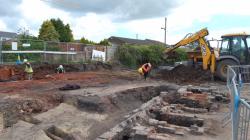 Hartlepool - A two hundred year old pottery has been discovered on a construction site in Hartlepool. Work had already started on a 30-home development in the Coxhoe area when part of kiln was discovered last month. An archaeological team were brought in and further excavation unearthed a larger site dating back to the mid-19th century. The construction company knew they were building on the site of Coxhoe Potteries, but were surprised how much was uncovered. The excavation is now into it's seventh week.
Hartlepool - A two hundred year old pottery has been discovered on a construction site in Hartlepool. Work had already started on a 30-home development in the Coxhoe area when part of kiln was discovered last month. An archaeological team were brought in and further excavation unearthed a larger site dating back to the mid-19th century. The construction company knew they were building on the site of Coxhoe Potteries, but were surprised how much was uncovered. The excavation is now into it's seventh week.
http://www.itv.com/news/tyne-tees/2015-06-11/archaeological-excavations-on-construction-site-unearth-teessides-pottery-past/?